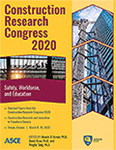Construction Research Congress 2020
How to Improve Workforce Development and Sustainability in Construction
Publication: Construction Research Congress 2020: Safety, Workforce, and Education
ABSTRACT
Due to the innate characteristics of the construction industry, including the dynamic and cyclical nature of construction operations, employee turnover rates in construction remain high. The high employee turnover rates present substantial challenges to industry stakeholders. In addition, the construction industry faces a significant shortage of skilled laborers across different work classifications. These persistent challenges make it paramount to initiate a systematic process, based on research and feedback from industry experts, to attract and develop a skilled workforce in the construction industry, and then implement strategies to maintain and retain the developed workforce. A systematic process increases workforce sustainability, a measure of the extent to which a workforce is sustainable. The objectives of the present study were to investigate the foundational attributes contributing to workforce sustainability in construction and potential strategies to address each attribute. A review of literature was initially carried out to identify relevant studies on the topic. After identifying relevant studies, qualitative methods involving content and thematic analyses were employed to identify attributes of construction workforce sustainability. Findings from the analysis indicate that there are eight foundational attributes contributing to construction workforce sustainability, namely: nurturing, diversity, equity, health and well-being, connectivity, value, community, and maturity. In response to the recognized list of attributes, the study identified multiple strategies to assess and enhance each of the workforce sustainability attributes. Construction companies can adopt these strategies to develop and sustain a skilled, motivated, and productive workforce.
Get full access to this article
View all available purchase options and get full access to this chapter.
ACKNOWLEDGEMENT
This study was funded by the Center for Construction Research and Training (CPWR) through cooperative agreement number U60-OH009762 from the National Institute for Occupational Safety and Health (NIOSH). Opinions and views expressed in this paper are the responsibility of the authors and do not necessarily represent the official views of CPWR or NIOSH. The authors thank CPWR and NIOSH for providing funding to conduct the study.
References
Attride-Stirling, J. (2001). “Thematic networks: an analytic tool for qualitative research.” Qualitative Research, 1(3), 385-405.
Bae, H., Simmons, D. R., and McCall, C. (2019). “Construction companies as facilitators of satisfying work environments.” In Proceedings of the 17th Annual Engineering Project Organization Conference (EPOC), Vail, CO, 1-14.
Chini, A., Brown, B., and Drummond, E. (1999). “Causes of the construction skilled labor shortage and proposed solutions.” In ASC Proceedings of the 35th Annual Conference, San Luis Obispo, CA, 187-196.
CPWR (2018). The construction chart book: The U.S. construction industry and its workers, Sixth edition. The Center for Construction Research and Training, Silver Spring, MD.
Dai, J., Goodrum, P., and Maloney, W. (2009). “Construction craft workers’ perceptions of the factors affecting their productivity.” J. Constr. Eng. Manage., 135(3), 217-226.
Escamilla, E. and Ostadalimakhmalbaf, M. (2016). “Capacity building for sustainable workforce in the construction industry.” The Professional Constructor, 41(1), 51-62.
Gambatese, J., Karakhan, A., and Simmons, D. R. (2019). “Development of a workforce sustainability model for construction. The Center for Construction Research and Training.
Groves, T., and Abbasi, K. (2004). “Screening research papers by reading abstracts.” The BMJ, 329(7464), 470-471.
Guest, G., MacQueen, K., and Namey, E. (2012). “Applied thematic analysis.” First edition, Sage Publications, Inc.
Ho, P. (2016). “Labour and skill shortages in Hong Kong’s construction industry.” Engineering, Construction and Architectural Management, 23(4), 533-550.
JUST (2017). “JUST. user manual.” Version 1.0. International Living Future Institute, Seattle, WA. <https://living-future.org/wp-content/uploads/2019/01/19-0110-Just-Manual.pdf>; (March 1, 2019).
Karimi, H., Taylor, T., Dadi, G., Goodrum, P., and Srinivasan, C. (2018). “Impact of skilled labor availability on construction project cost performance.” J. Constr. Eng. Manage., 144(7), 04018057.
Kossek, E., Valcour, M. and Lirio, P. (2014). “The sustainable workforce: Organizational strategies for promoting work-life balance and wellbeing.” Work and Wellbeing: Wellbeing: A Complete Reference Guide, III, 295-319.
Lingard, H., Brown, K., Bradley, L., Bailey, C., and Townsend, K. (2007). “Improving employees’ work-life balance in the construction industry: Project alliance case study.” J. Constr. Eng. Manage., 133(10), 807-815.
Mani, V., Agrawal, R., and Sharma, V. (2014). “Supplier selection using social sustainability: AHP based approach in India.” International Strategic Management Review, 2(2), 98-112.
Nordquist, R. (2019). “Definition and examples of function words in English.” ThoughtCo. <https://www.thoughtco.com/function-word-grammar-1690876>; (July 9, 2019).
Piper, C. and Madadi, V. (2018). “Are we on the same jobsite? The millennial generation vs. construction industry employees.” The Professional Constructor, 42(2), 26-38.
Sing, M., Tam, V., Fung, I., and Liu, H. (2018). “Critical analysis on construction workforce sustainability in developed economy.” Engineering Sustainability, 171(7), 342-350.
Thomas, J. (2013). “Study on causes and effects of employee turnover in construction industry.” International Journal of Science and Research (IJSR), 4(5), 2319-7064.
Valdes-Vasquez, R., and Klotz, L. (2013). “Social sustainability considerations during planning and design: Framework of processes for construction projects.” J. Constr. Eng. Manage., 139(1), 80-89.
Winwood, P. C., Colon, R., and McEwen, K. (2013). “A practical measure of workplace resilience: developing the resilience at work scale.” Journal of Occupational and Environmental Medicine, 55(10), 1205-1212.
Information & Authors
Information
Published In
Construction Research Congress 2020: Safety, Workforce, and Education
Pages: 21 - 30
Editors: Mounir El Asmar, Ph.D., Arizona State University, David Grau, Ph.D., Arizona State University, and Pingbo Tang, Ph.D., Arizona State University
ISBN (Online): 978-0-7844-8287-2
Copyright
© 2020 American Society of Civil Engineers.
History
Published online: Nov 9, 2020
Published in print: Nov 9, 2020
Authors
Metrics & Citations
Metrics
Citations
Download citation
If you have the appropriate software installed, you can download article citation data to the citation manager of your choice. Simply select your manager software from the list below and click Download.
